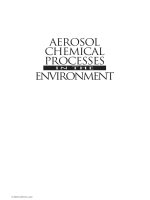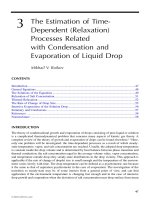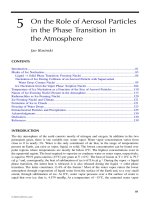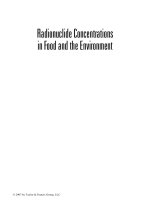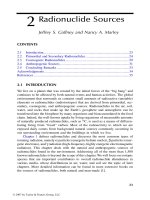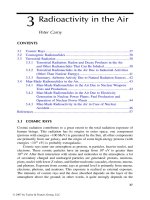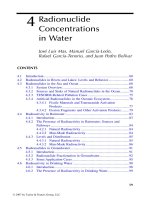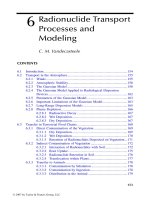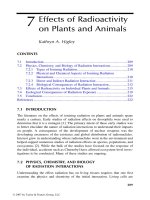Radionuclide Concentrations in Foor and the Environment - Chapter 11 pot
Bạn đang xem bản rút gọn của tài liệu. Xem và tải ngay bản đầy đủ của tài liệu tại đây (495.23 KB, 10 trang )
367
11
Radiation Protection
Programs
R. J. Emery and M. A. Charlton
CONTENTS
11.1 Introduction 367
11.2 Anticipation 368
11.3 Recognition 371
11.4 Evaluation 372
11.5 Control 372
11.5.1 Preexposure Controls 372
11.5.2 Laboratory Exposure Controls 373
11.6 Conclusion 374
11.7 Supplemental Reading 376
11.1 INTRODUCTION
Radiation protection programs strive to prevent or minimize the harmful effects
of radiation sources for those individuals in laboratories involved with the analysis
of radioactivity in food and the environment. Sources of radiation inherent to
these analytical processes and procedures include ionizing waveforms, particulate
radiation, and frequently nonionizing radiation. Sources of ionizing radiation may
be used as encapsulated standards for the calibration of counting equipment or
in dispersible forms for radiolabeling or internal standardization procedures.
Ionizing radiation may also be encountered in the form of radiation producing
devices, such as analytical x-ray machines, electron microscopes, or x-ray dif-
fraction devices. Sources of nonionizing radiation, in particular high-energy
lasers, are also increasingly being used in analytical devices. The unknown
analytical sample in the lab may also contain radioactivity. Samples of food and
environmental media contain myriad radionuclides in variable concentrations
stemming from natural sources or from environmental releases. With all of these
different types of sources that might be present in any analytical lab, and the
various pathways for potential exposure, the development of a vigilant radiation
protection program to protect the health of the individuals associated with the
lab activities is considered to be a necessity.
DK594X_book.fm Page 367 Tuesday, June 6, 2006 9:53 AM
© 2007 by Taylor & Francis Group, LLC
368
Radionuclide Concentrations in Food and the Environment
Laboratory safety programs may be considered integral to an overall philos-
ophy of quality control and improvement. A robust safety program prevents
contamination, promotes laboratory hygiene, and espouses the “do no harm”
philosophy. The enhanced quality embedded within these elements prevents lab-
oratory injuries, improves sample analysis, and reduces laboratory overhead costs.
Therefore laboratories engaged in quality management programs often dedicate
resources to safety enhancements.
A radiation protection program is, in effect, a management system that affords
an organization the ability to anticipate, recognize, evaluate, and control sources of
radiation that might be present in the workplace. Radiation protection programs
represent more than just monitoring for the radiation levels present. Robust radiation
protection programs include considerations for facility design and engineering
controls, personal protective equipment, administrative controls, records review,
professional development, and emergency preparedness. Such comprehensive
approaches to safety programs have been recognized as standard industry practice,
and are considered so important that they are required by some regulatory agen-
cies. Although variability exists among various regulatory entities, a finite set of
recognized prudent radiation protection program elements are identifiable. This
chapter discusses these common elements and provides examples of the measures
that can be employed to create a successful program that protects the health and
safety of individuals in the analytical laboratory work setting. Other hazards
within the analytical laboratory may require similar management systems. Many
laboratories possess biological agents, chemicals, and physical agents in addition
to the radiological sources outlined in this chapter. These hazards should warrant
additional management systems beyond the scope of this chapter.
Figure 11.1 outlines a pragmatic schema for describing the overarching prin-
ciples of anticipation, recognition, evaluation, and control of radiation sources in
the laboratory. Within each principle are subprocedures or considerations which
the laboratory should consider to complement their radiation protection program.
11.2 ANTICIPATION
The first phase in the development of a comprehensive radiation protection
program is anticipating the radiation sources to be encountered. In an effort to
anticipate potential workplace hazards, safety must be included in the overall
laboratory mission. This tangible management support is critical for new or
developing radiation safety programs. Strong executive support transfers into
prompt anticipation and remediation of occupational hazards.
The anticipation phase typically consists of a review of the overall mission
of the laboratory and then the creation of a simple process flowchart that tracks
the radiation sources as they pass through the organization. Figure 11.1 contains
a conceptual schema to assist in the development of a laboratory process flow-
chart. It is important to include in this process diagram both the sources inherent
DK594X_book.fm Page 368 Tuesday, June 6, 2006 9:53 AM
© 2007 by Taylor & Francis Group, LLC
Radiation Protection Programs
369
in the samples to be analyzed and any sources inherent in the analytical tools
and procedures as well.
A typical process flow diagram begins with the delivery and receipt of the
radiation source. Laboratories should be designed so that sources are received in
a controlled area that is away from normal operations. Keeping the source receipt
area away from normal operations prevents the possibility of facility contamination
FIGURE 11.1
Generic process considerations for the delivery, receipt, preparation, use,
and release of radiation sources.
________________________________________________________________________
Process phase Considerations
________________________________________________________________________
Delivery Notification for deliveries
Receipt Radionuclide expected
Physical form
Amount
Frequency of receipt
Methods for receipt monitoring
Addition to inventory
Interim storage
Security of facility during receipt and interim storage
Preparation and use Transport to worksite
User training
Protective equipment
Engineering controls
Manipulations
Chemical reactions
Mechanical manipulations
Worksite safety surveys
Monitoring
Emergencies
Quality Assurance / Quality Control
Consideration of pathways for releases
Postings, access controls
Data analyses and interpretation
Disposition How will waste or unused sources accumulation occur?
Options for return to supplier?
Means for assay for verification of content
Storage means
Processing
Disposal recycling
Security
Removal from inventory
Releases in other forms
Waste
Water
Air
________________________________________________________________________
DK594X_book.fm Page 369 Tuesday, June 6, 2006 9:53 AM
© 2007 by Taylor & Francis Group, LLC
370
Radionuclide Concentrations in Food and the Environment
if a package is found to be leaking and minimizes the impact of background
radiation levels that can adversely impact sensitive radioanalytical procedures.
Since some sources may arrive in heavy shipping containers, or may be in various
forms of environmental media, consideration must be given to material handling
aspects, such as the use of carts or lifts. Upon receipt, the radiation source must
be characterized and inventoried so that a complete accounting of the radiation
sources present at any time can be maintained. During the receipt phase, consid-
eration must be given to the radiological monitoring of the transport package to
verify integrity. Provisions for interim storage of any source must be made so
that the source is properly secured and maintained in appropriate environmental
conditions. For example, some samples may need to be maintained in a frozen
state, whereas others may need to be maintained at room temperature conditions
at all times. Other samples may hold the possibility of offgassing either potentially
hazardous gases or nuisance odors, which may warrant the need for storage with
local exhaust ventilation. All of these types of requirements should be anticipated
prior to the initiation of activities.
After the source receipt phase, the typical process flow leads to the preparation
of the source for use or analysis. In this phase, needs for source handling,
contamination control, shielding, and local exhaust ventilation should be antici-
pated. Accommodations should also be made for upset conditions. For example,
if a sample leaks, the pathways for fluid flow should be anticipated. Similarly, if
the potential for gases or vapors may be present, the fate of these should be
considered as well.
Since it is not uncommon for laboratory analyses to subject samples to
elevated temperatures, pressures, or chemical reactions in order to extract or
isolate targeted components of interest, such processes should also be anticipated,
as they can result in releases and possible exposures.
The last stage of the process analysis considers the release, discharge, or
disposal of the source. By anticipating the need for space and equipment to
address the accumulation and subsequent disposal of waste materials, the radia-
tion protection program will be developed in a manner that addresses the entire
scope of operations.
Once a general process flow has been diagrammed, then certain operating
parameters can be circumscribed. Estimates describing the number of sources or
samples to be received and the average daily and weekly volumes help establish
operating bounds for the organization. Such operating parameters are necessarily
limited by aspects such as organizational staffing and facility space. Within these
operating bounds, accommodations should be made for possible emergency sit-
uations, such as when a massive number of samples might be received due to an
unusual event, along with envisioned general increases in volume due to organi-
zational growth. These operating boundaries can then serve to drive facility design
or modification needs and will aid in the facility permitting process as well.
Armed with the information gained from the anticipation phase of radiation
protection program development, the focus can now be directed toward the
recognition phase of the process.
DK594X_book.fm Page 370 Tuesday, June 6, 2006 9:53 AM
© 2007 by Taylor & Francis Group, LLC
Radiation Protection Programs
371
11.3 RECOGNITION
Since humans cannot detect the presence of radiation with any of our sensory
pathways, we must rely on other means to recognize its presence. Thus, recog-
nition of possible radiological hazards is typically accomplished through a com-
bination of worker education and administrative access controls and postings.
Worker education should be considered a cornerstone for any radiation pro-
tection program. An educated workforce can lead to the installation of a safety
culture wherein safety becomes an unquestionable part of every aspect of work.
When this type of environment is installed, all of the other programmatic issues
fall neatly into place. Although specific regulatory requirements regarding radi-
ation safety training vary (Table 11.1 shows the training elements for radiation
workers in Texas), all should enable workers to answer the basic following
questions:
• What are the risks inherent to my job, and where are they?
• What steps do I take to perform my job in a safe manner?
• Where can I obtain additional information or assistance?
• What do I do in case of an emergency?
Equally important to providing this basic information, educational programs
should also serve as a platform for conveying an organizational commitment to
safety and genuine concern for its workers. All too often, excellent educational
content is provided via a format that does not effectively convey this message.
For example, when a new employee is provided basic radiation safety training
via videotape or computer terminal, an unintended message could be that the
organization is not truly dedicated to this aspect of operations and is more
interested in fulfilling some regulatory requirement. Radiation protection pro-
grams should make a concerted effort to avoid this unintended outcome.
TABLE 11.1
Radiation Protection Topics Required by Regulatory
Authorities in Texas (25 TAC 289.203(c))
Topic
Regulatory
Reference
Storage, transfer, use of workplace radiation sources 289.203(c)(1)(A)
Health protection problems associated with radiation 289.203(c)(1)(B)
Precautions and procedures needed to minimize exposure 289.203(c)(1)(B)
Instructed in applicable radiation protection regulations 289.203(c)(1)(C)
Instructed to report any incident or violation 289.203(c)(1)(D)
Emergency response procedures and warning 289.203(c)(1)(E)
Radiation exposure reports involving the employee 289.203(c)(1)(F)
DK594X_book.fm Page 371 Tuesday, June 6, 2006 9:53 AM
© 2007 by Taylor & Francis Group, LLC
372
Radionuclide Concentrations in Food and the Environment
To verify that the necessary educational content has been understood by
workers, some type of educational assessment tool is needed. This may be in the
form of a test or a series of signed acknowledgements, but regardless of the format,
it is important to ensure in documented form that the student left the training
session with the knowledge to perform work safely, and where to turn if questions
arise.
An essential part of any radiation safety educational effort includes informa-
tion on how to recognize where radiation might be present. Workers should be
educated about the various warning signs and barriers that may be placed around
areas where radiation sources are used. Descriptions of actual source containers
are also useful.
11.4 EVALUATION
Once the source term for the work area has been established and the specific
locations of use established, then evaluation of the radiation protection program
can begin. Typical program evaluations consist of routine surveys to ensure that
radiation levels are being maintained as low as reasonably achievable (ALARA)
and that contamination is controlled within workspaces and at acceptable levels.
Routine surveys should not be limited merely to the detection of radiation, and
should include an assessment of programmatic aspects such as the presence of
postings, documented worker training, and a review of regular work practices.
11.5 CONTROL
Radiation protection programs focus control efforts in three primary phases: prior
to the use of radiation sources, during the use of radiation sources, and at the
time of ultimate disposition of the source. Each phase of radiation exposure
control employs distinct management techniques. The most effective radiation
protection program requires a team-based approach with support from executive
management, regulatory authorities, facility planners, radiation safety personnel,
the laboratory director, and laboratory staff.
11.5.1 P
REEXPOSURE
C
ONTROLS
A guiding principle of radiation protection practice involves minimizing or pre-
venting radiation exposure before laboratory work begins. This could include
consideration of the types of research protocols envisioned, facility construction,
engineering control in the form of directional airflow, or security controls in the
form of locks and identification card readers. In the laboratory setting, two of the
most common administrative controls are peer review safety committees and
consideration of radiation source substitution.
Many regulatory authorities promulgate standards that mandate health care
and research settings convene a properly constituted “Radiation Safety Commit-
tee.” In general, a facility Radiation Safety Committee possesses the ability to
DK594X_book.fm Page 372 Tuesday, June 6, 2006 9:53 AM
© 2007 by Taylor & Francis Group, LLC
Radiation Protection Programs
373
approve new uses of radioactive material, new radionuclides, or even new radio-
active material laboratories. The goal of the peer Radiation Safety Committee is
to evaluate the hazards of radiation exposure and recommend control measures
to the investigator. This peer review methodology for hazard assessment and
control has a solid foundation in the laboratory due to the common presence of
other institutional review committees (e.g., Institutional Review Board).
Radiation source substitution focuses on the availability of alternative
research techniques to minimize or prevent exposure to radioactive materials. For
example, if the laboratory requests the use of
32
P (
E
max
= 1.7 MeV B
–
), source
substitution philosophy dictates the consideration of
33
P (
E
max
= 0.25 MeV B
–
).
In this example, a
32
P laboratory nucleotide may be easily substituted with
33
P to
accomplish the same scientific goals with a lower energy product. The most
effective source substitution occurs prior to exposure and before the laboratory
generates data. Therefore formally incorporating these goals into the Radiation
Safety Committee’s charter and operations may be helpful.
11.5.2 L
ABORATORY
E
XPOSURE
C
ONTROLS
Radiation safety programs employ a tiered approach to managing radiation expo-
sures during routine laboratory operations. This multifaceted approach includes
aggressive employee safety training, “dry run” walk-throughs, laboratory director
feedback, workplace surveillance, exposure monitoring, and pragmatic radiation
protection program review. When taken together as a systematic approach, this
exposure minimization plan is circular, with the continual goal of reducing lab-
oratory radiation exposures.
The dynamic nature of the laboratory work setting dictates an aggressive
worker safety training program. Most regulatory authorities will prescribe certain
radiation safety training topics. Table 11.1 illustrates the common topics required
by the radiation control authority in Texas. In reviewing Table 11.1, these topics
may be considered rather general and not specific to the laboratory setting. Most
laboratory directors will require significantly more detailed treatment of occupa-
tional hazards in order to prevent hazardous exposures in the laboratory setting.
Radiation protection standards require the level or duration of training be com-
mensurate with the level of hazard presented by the radiation source. Laboratory
safety training also commonly uses “dry run” walk-throughs and continual feed-
back from the laboratory director.
The “dry run” method of training enables a laboratory worker to progress
stepwise through a new laboratory protocol without the inclusion of radioactive
material. Laboratory workers may then plan out details such as the physical layout
of the laboratory bench, placement of portable shielding, critical equipment, and
radioactive waste containers. This important training initiative generally results
in lower radiation doses for new laboratory workers by minimizing the time
around radiation sources and improving process knowledge.
Workplace surveillance programs enable an unbiased observer to review the
use, storage, and containment of radiation sources in the laboratory setting. These
DK594X_book.fm Page 373 Tuesday, June 6, 2006 9:53 AM
© 2007 by Taylor & Francis Group, LLC
374
Radionuclide Concentrations in Food and the Environment
observations are then presented to the laboratory director in order to reduce
radiation exposures in the laboratory. Workplace surveillance programs may be
initiated by the laboratory director or the facility radiation safety personnel. A
common approach involves the use of a published survey tool, removable con-
tamination surveys, and an ambient radiation level survey. The survey tool or
checklist enables a trained observer to evaluate the same laboratory situations in
each facility laboratory. A further benefit of the survey tool is that the laboratory
director or staff may periodically self-assess the safety of their program. Figure
11.2 provides an example of a common laboratory radiation safety survey tool.
All radiation sources must have caution signs and hazard warnings denoting
the presence of ionizing radiation in the workplace. This signage generally takes
the form of the universal “trefoil” symbol with yellow background/magenta
lettering or yellow background/black lettering. Figure 11.3 is an example of the
common radiation trefoil symbol.
11.6 CONCLUSION
Ionizing radiation presents an important risk to the general public and in many
workplaces. The preventive measures described in the text outline prudent steps
for eliminating or mitigating the hazard posed by these ionizing radiation sources.
The comprehensive philosophy of anticipation, recognition, evaluation, and control
of ionizing radiation sources yields a framework for the safe and healthful use
of these sources.
Further refinements in the risk factors, biological outcomes, uses, and tech-
nology surrounding radiation exposure should be anticipated. New international
recommendations for radiation protection are routinely revised and reissued. This
process lends itself to pragmatic review of all operations with exposure to radi-
ation hazards. Therefore the guidelines suggested throughout the text should be
viewed as a current evaluation of the status, but continuous improvement, work
practice controls, and engineering controls should be adopted.
The use of potential carcinogens in the workplace places a heavy burden on
the radiation protection program administrators because of the potential for seri-
ous biological endpoints. A sensible approach to evaluating, mitigating, or elim-
inating the risk to occupationally exposed individuals is critically important.
These steps, taken in conjunction with standard laboratory practices, provide a
solid foundation for engaging in the benefits of ionizing radiation while offsetting
the negative outcomes.
DK594X_book.fm Page 374 Tuesday, June 6, 2006 9:53 AM
© 2007 by Taylor & Francis Group, LLC
Radiation Protection Programs
375
FIGURE 11.2
Radioactive material laboratory safety evaluation survey tool.
University of Texas-Houston health science center
Environmental Health and Safety Department
Radiation Safety Division
Laboratory Safety Evaluation Record
Date Performed:________________ Page: 1
Date Printed: 1/13/2006
Procedure: Evaluate each of the following items according to the requirements of the Radiation Safety Manual,
June 1996. Place a check in the appropriate space for either Y (YES), N (NO), or N/A (Not
Applicable). Enter comments in the provided space.
YNN/A Comments?
General Safety
General housekeeping orderly? _______________________________
Current emergency contact phone numbers posted?
_______________________________
Hazard communication training attendance?
_______________________________
Linear air flow rate in hood adequate?
_______________________________
Measured linear flow rate:____________lfpm
Is the hood air flow laminar?
_______________________________
No food or drink observed in laboratory?
_______________________________
Fire Safety
Fire egress unobstructed? _______________________________
Fire extinguisher available?
_______________________________
Electrical circuit load appears normal?
_______________________________
Physical Safety
Absence of trip hazards? _______________________________
Compressed gas cylinders secured?
_______________________________
Personal protective equipment used?
_______________________________
Guards in place for mechanical hazards
_______________________________
Biological Safety
Biohazard laboratories properly posted?
_______________________________
Universal precautions utilized?
_______________________________
Biological safety cabinet certified (annual)?
_______________________________
Ultraviolet lamps used properly & posted?
_______________________________
Biohazard waste properly stored?
_______________________________
Chemical Safety
NFPA rating present?
_______________________________
Chemicals stored properly?
_______________________________
No flammables stored in refrigerator?
_______________________________
Chemical waste properly stored?
_______________________________
Radiation Safety
Appropriate CRAM signs posted (door, hood, ref, etc.)? _______________________________
Properly documented lab survey records present?
_______________________________
Wipe test equipment appropriate & functioning?
_______________________________
Current Radiation Safety Manual available?
_______________________________
Current NTE & emergency procedures posted?
_______________________________
Radionuclide storage & security adequate?
_______________________________
Personnel monitoring utilized and appropriate?
_______________________________
Survey instrument available, calibrated, & functioning?
_______________________________
Radioactive waste stored properly?
_______________________________
No additional safety concerns?
_______________________________
Any unsatisfactory safety condition or concern must be relayed to the appropriate Environmental Health & Safety Division
Relayed To: Date: Concern(s):
DK594X_book.fm Page 375 Tuesday, June 6, 2006 9:53 AM
© 2007 by Taylor & Francis Group, LLC
376
Radionuclide Concentrations in Food and the Environment
11.7 SUPPLEMENTAL READING
Charlton, M.A. and Emery, R.J., An analysis of reported incidents involving radiophar-
maceuticals for the development of intervention strategies,
Health Phys.
, 81, 585,
2001.
Emery, R.J., Adding value to your radiation protection program, in
Management and
Administration of Radiation Safety Programs
, Roessler, C.E., ed., Medical Physics
Publishing, Madison, WI, 1998.
Emery, R.J., Charlton, M.A., and Goodman, G.R., Texas radiation protection program
outcomes as indicated by regulatory compliance activities from 1988 to 1997,
Health Phys.
78, 335, 2000.
Emery, R.J., Charlton, M.A., and Mathis, J.L., Estimating the administrative costs of
regulatory noncompliance: a pilot method for quantifying the value of prevention,
Health Phys.
, 78(5 suppl.), S40, 2000.
Emery, R.J., Charlton, M.A., Orders, A.B., and Hernandez, M., Using fault tree analysis
to identify causes of non-compliance: enhancing violation outcome data for the
purposes of education and prevention.
Health Phys
. 80(suppl. 1), S16, 2001.
Emery, R.J., Pollock, J., and Charlton, M.A., Notices of violation issued to Texas radio-
active material licensees inspected in 1995,
Health Phys.
, 73, 706, 1997.
Texas Department of Health, Texas regulations for the control of radiation, Bureau of
Radiation Control, Austin, TX, 2002.
U.S. Nuclear Regulatory Commission, Standards for protection against radiation, Title 10
CFR part 20, 1991.
U.S. Nuclear Regulatory Commission, Uses of radioactive material, NUREG/BR-0217,
U.S. Nuclear Regulatory Commission, Washington, DC, 1996.
FIGURE 11.3
Common radiation trefoil symbol. The color version has magenta coloring
on a yellow background.
DK594X_book.fm Page 376 Tuesday, June 6, 2006 9:53 AM
© 2007 by Taylor & Francis Group, LLC
